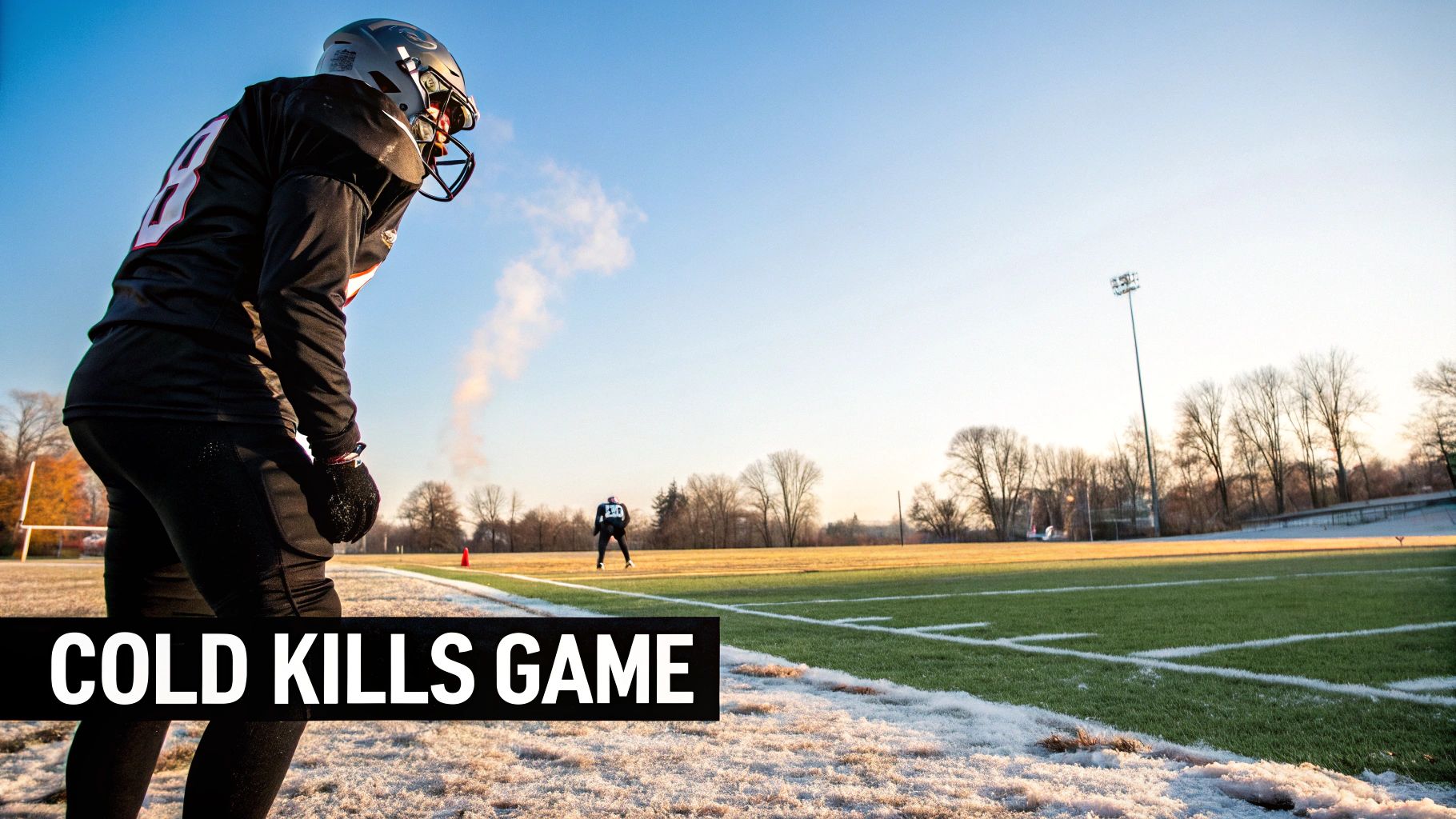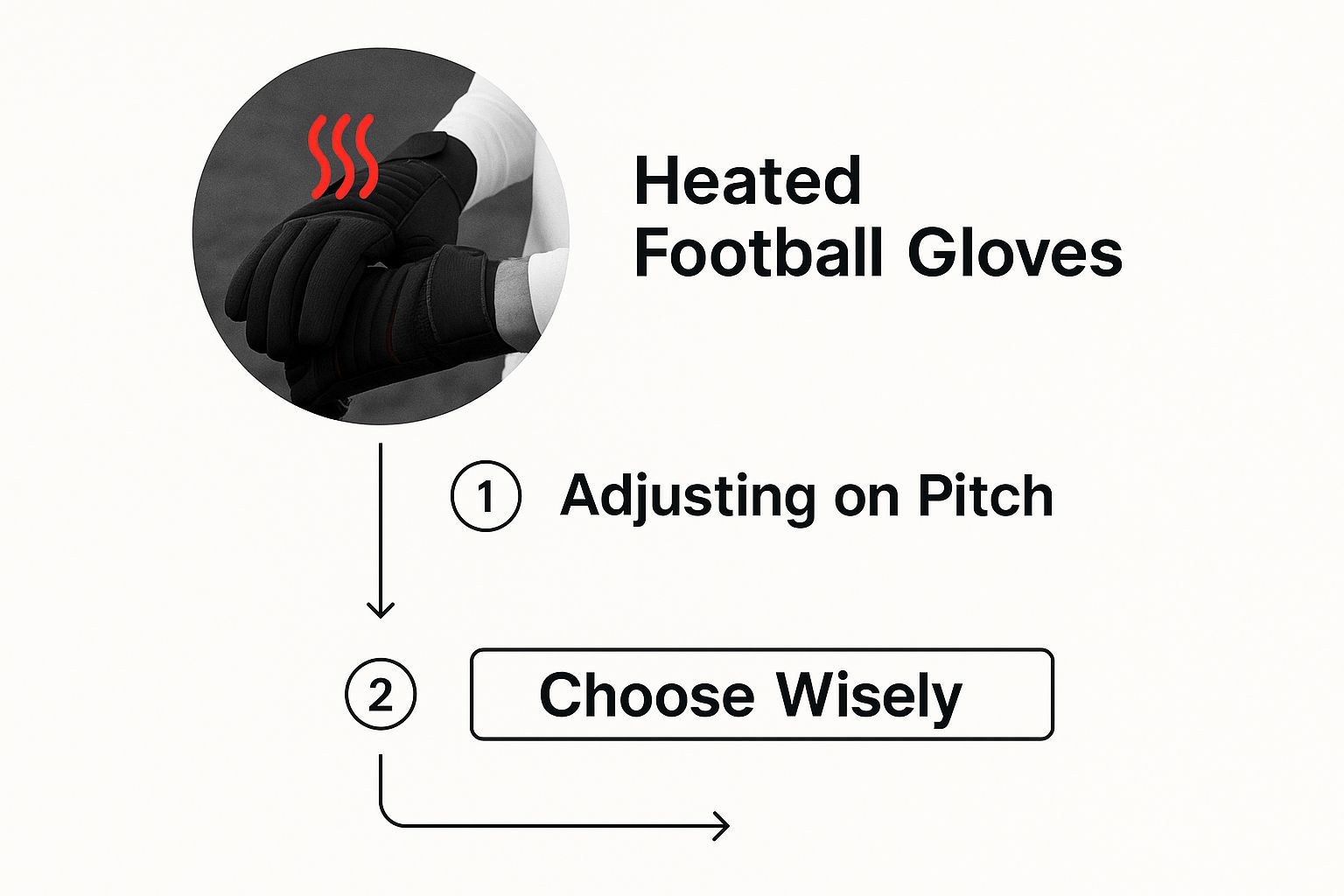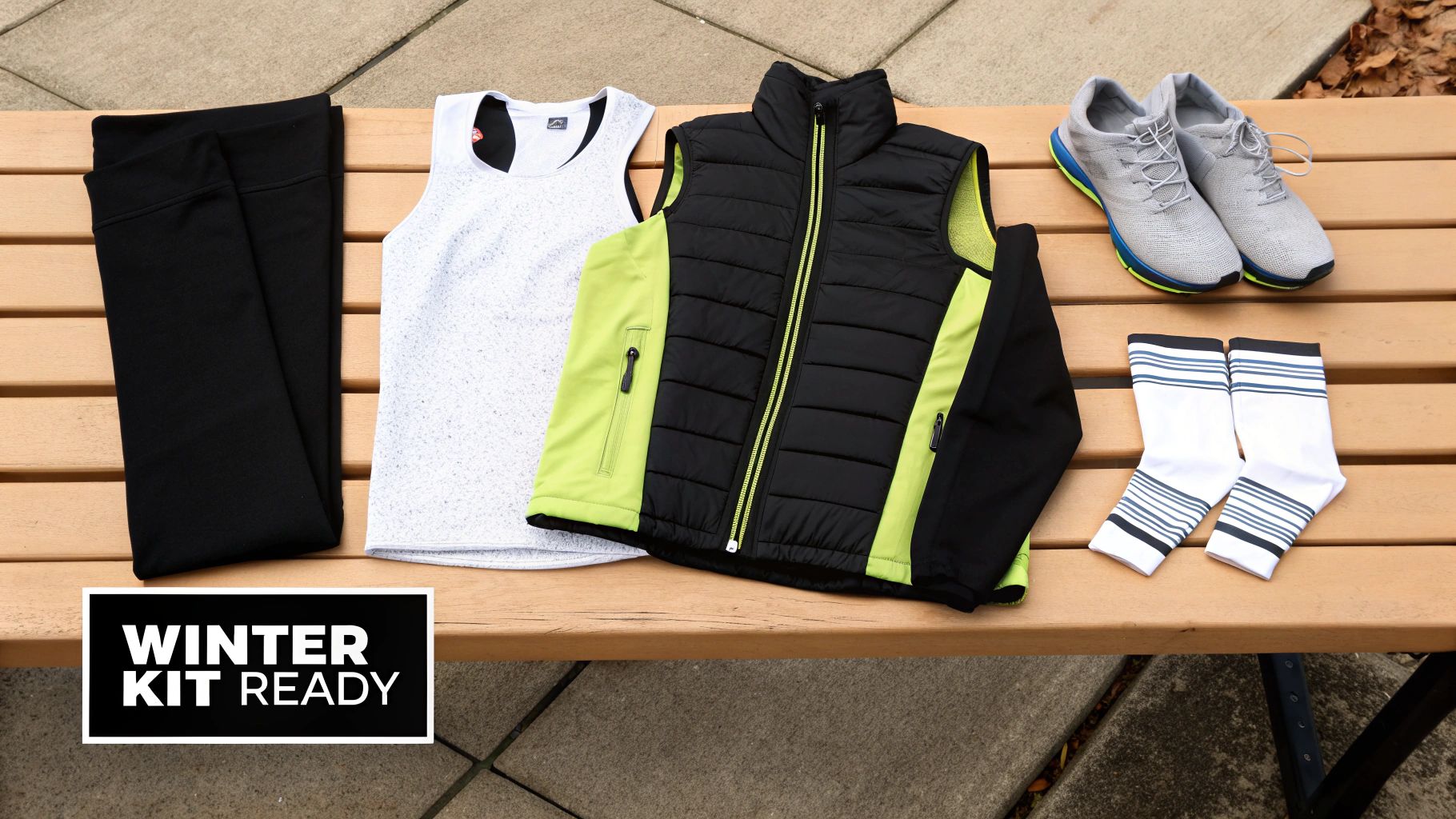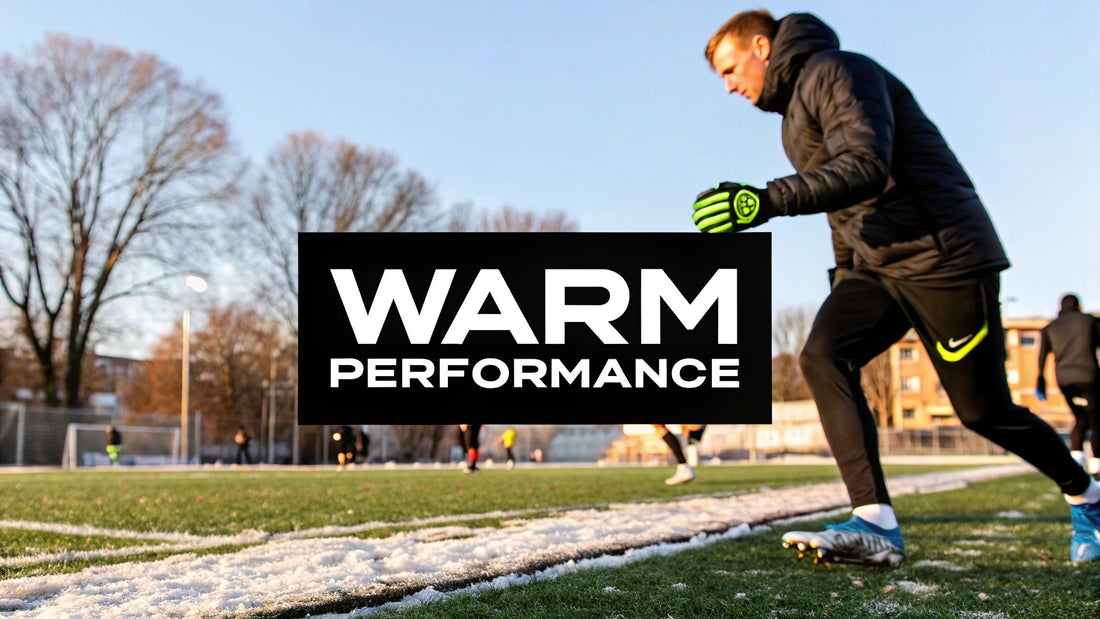When the temperature drops, your performance doesn't have to. Modern heated football gloves and training wear aren't just an extra layer; they're an active, battery-powered advantage. By generating their own heat, this gear keeps your hands nimble and your core muscles primed for action, directly countering the performance dip every player in the UK knows too well.
This technology is a significant step up from standard thermal clothing. For those freezing training sessions and frosty Sunday league matches, generating your own warmth is a genuine game-changer.
Why Cold Weather Is the Opposition You Can't See

That biting winter wind isn't just uncomfortable—it's a performance killer. As soon as the temperature plummets, your body goes into survival mode, pulling blood flow away from your extremities to keep your vital organs warm. For a footballer, this means stiff fingers, numb toes, and tight, unresponsive muscles.
This natural reaction has immediate on-pitch consequences. A defender’s fumbled throw-in, a midfielder’s misplaced pass, or a striker taking a fraction of a second too long to get a shot away. Often, these mistakes can be traced back to the cold's impact. Your focus shifts from reading the game to simply trying to stay warm.
The Hidden Risks of Playing in the Cold
It's not just about sloppy play. Training in the cold without the right gear seriously increases your risk of muscle strains and pulls. Cold muscles lack flexibility and are far more prone to injury during explosive movements like sprinting, jumping, or tackling. On top of that, your body burns through energy much faster as it works overtime just to maintain its core temperature.
This is where modern heated football gloves and training wear make a genuine difference.
Players are taking this seriously. The United Kingdom holds a significant 18.90% share of the European football gloves market, highlighting how crucial proper equipment has become for amateur and professional players alike.
Instead of just trapping body heat, this technology actively generates its own warmth. It’s the difference between merely surviving a winter session and dominating it—a tactical advantage that keeps you sharp when opponents are shivering.
Maintaining Performance and Stamina
By keeping your hands functional and your core muscles warm, heated gear allows you to maintain peak physical readiness. You’re not wasting energy fighting the cold, meaning your technique stays sharp and your body is primed for intense effort. This preparation is vital for turning a harsh environment into a home-field advantage. To get a better handle on physical readiness, check out our guide on how to build stamina for football.
Choosing the Right Heated Football Gloves
Not all heated gloves are created equal. What looks good online doesn’t always hold up on the pitch during a freezing Sunday morning match. To choose the right pair, you need to focus on the features that actually impact your game.
A good pair of heated football gloves should feel like an extension of your hands, not a bulky distraction. This is why getting the fit and dexterity right is so crucial. You need them snug enough to feel the ball for a quick throw-in but not so tight they restrict circulation—that would defeat the purpose entirely.
Making the right choice is a key part of your cold-weather preparation. The infographic below breaks down the essential factors to consider.

As you can see, a smart choice comes down to balancing battery life, heating element coverage, and grip. Each of these factors is critical when you’re out on the pitch.
To make this even easier, here’s a quick-glance table comparing the essential features to look for.
Heated Glove Feature Comparison
| Feature | What to Look For | Why It Matters for Football |
|---|---|---|
| Battery Life | At least 2-3 hours on medium/high settings. | Must last a full 90-minute match plus warm-ups without failing at a critical moment. |
| Heating Elements | Coverage that extends to the fingertips. | Your fingers lose heat fastest; keeping them warm is key for dexterity and ball control. |
| Material & Grip | Water-resistant outer shell with a silicone palm. | Essential for staying dry in UK weather and maintaining a solid grip on a wet, slippery ball. |
| Fit & Dexterity | A snug, flexible fit that isn't restrictive. | Allows for a natural feel on the ball for throw-ins and general handling, preventing distraction. |
| Insulation | Soft fleece or thermal lining inside. | Adds an extra layer of warmth and comfort without adding excessive bulk. |
This table provides a solid checklist. Now, let’s explore a couple of those points in more detail.
Battery Life and Heating Elements
The heart of any heated glove is its battery and how effectively it distributes heat. Don’t just look at the maximum battery life advertised. What you really need to know is how long it lasts on the medium and high settings, as this is what you’ll use in genuinely cold conditions. A full 90-minute game demands consistent warmth, and a battery that dies at half-time is useless.
Equally important is where the heat is directed. Many cheaper gloves only warm the back of the hand. Superior models feature heating elements that run all the way to the fingertips. It’s your fingers that feel the cold most, and keeping them warm is what maintains your control and dexterity.
Look for gloves with carbon fibre heating elements. They’re lightweight, flexible, and distribute heat evenly across the whole hand and fingers—exactly where footballers need it most.
Materials, Grip, and Weather Resistance
For anyone playing in the UK, materials are a deal-breaker. A water-resistant outer shell is essential to keep your hands dry during drizzly training sessions. Inside, a soft fleece or thermal lining provides comfort and extra insulation.
The palm connects you to the ball. A silicone-patterned palm gives you a reliable grip, even when the ball is wet and slick. This is what transforms the gloves from a hindrance into an advantage, especially for throw-ins. Finding the right pair on a site like SoccerWares is about matching these practical features to your needs.
It's no surprise that demand for such specialised gear is rising. The global market for heated football gloves was valued at around $101 million in 2023 and is projected to reach $369.5 million by 2032. This growth is driven by players who want to stay comfortable, prevent injuries, and maintain high performance levels when the temperature plummets.
Building Your Complete Winter Training Kit

A good pair of gloves is a great start, but winning the battle against the cold requires a complete kit strategy. Modern performance wear is about smart, technical layering to build a versatile system that works for a frosty morning session or a damp evening match.
At the heart of any solid winter setup is the three-layer principle. It's a strategic approach that keeps you warm and dry without weighing you down or restricting movement—vital for staying agile on the pitch. Each layer has a specific job, and when they work together, it's the difference between shivering through a drill and executing it perfectly.
The Three Core Layers of Football Training Wear
The traditional layering system is the gold standard for a reason. It creates a microclimate around your body that you can easily adjust as you warm up and cool down.
-
The Base Layer: This is your second skin. Its primary job is to wick moisture away from your body. A quality base layer, usually made from synthetic materials, pulls sweat off your skin to prevent the damp, chilling feeling that sets in when you stop moving.
-
The Mid-Layer: This is your insulation engine. A fleece or thermal top traps the warm air your body generates, creating a pocket of warmth that insulates you from the cold without adding unnecessary bulk.
-
The Outer Shell: This layer is your shield against the elements. A lightweight, weather-resistant jacket or gilet blocks wind and light rain—the biggest culprits for heat loss during a typical UK winter session.
Once you’ve sorted this foundation, you can integrate heated football gloves and training wear to gain a real edge.
Think of your layers as a system, not just a collection of clothes. The goal isn't just warmth, but thermoregulation—the ability to maintain a stable core temperature whether you're sprinting, jogging, or listening to the coach.
Integrating Heated Gear for Maximum Impact
This is where your kit becomes specialised. Instead of relying solely on trapped body heat, you’re actively generating warmth where you need it most. This allows you to stay warm with fewer, less bulky layers, preserving your freedom of movement.
A heated gilet worn over your base layer is a fantastic option. It sends warmth directly to your core, helping your body maintain blood flow to your hands and feet. This keeps your core temperature stable without the restrictive feel of a heavy jacket.
The same logic applies to your lower body. Pairing thermal leggings with heated socks ensures your leg muscles stay warm and pliable, ready for action. This is critical for preventing strains and pulls during explosive movements on a cold day.
Building this kind of advanced kit requires a good understanding of what’s available. For a deeper dive, check out this complete guide to football training wear, which covers everything from base layers to specialised outerwear. The goal is to create a dynamic, adaptable kit that works for you, no matter the conditions.
Getting the Most Out of Your Heated Gear on Match Day
Owning heated football gloves or a heated gilet is one thing; using them effectively on match day is another. A few simple tricks can make a massive difference when the temperature drops, helping you stay warm without draining your battery before the final whistle.
One of the best habits to adopt is pre-heating your gear. Switch on your gloves and any other heated kit for about 10-15 minutes before you leave the changing room. This traps a pocket of warm air from the start, so your body isn't fighting to warm up cold fabric the moment you step outside.
Smart Battery Management
It’s tempting to crank the heat to maximum as soon as you feel a chill. Don't. That’s the quickest way to end up with a dead battery by half-time. A smarter approach is to start on the lowest setting during your warm-up and only boost the power during breaks in play or when you’re on the bench.
Think of it like managing your stamina in a match—you don't sprint for the full 90 minutes. Conserve battery power for when you really need it.
Also, ensure the battery pack is secure and doesn't impede your movement. Most heated gilets have a dedicated internal pocket. For gloves or socks, check that the packs don’t rub or bounce around while you're running. A well-placed battery should be unnoticeable.
The Right Way to Layer
How you layer your kit over heated wear is crucial. Avoid trapping sweat by never layering non-breathable, waterproof fabrics directly on top of your heated garments. If you do, sweat gets trapped against your skin, and as soon as that moisture cools, you'll start to feel colder.
The goal is simple: let your heated gear do its job while allowing moisture to escape. Always pair it with breathable base layers and outer shells to keep yourself dry and comfortable.
This focus on advanced materials is something leading brands take seriously. Key players in the football gloves market, like Adidas and Nike, invest millions in research to improve designs with moisture-wicking synthetics and enhanced grip. This is driven by player demand for comfort and safety in challenging UK weather. You can discover more insights about the evolution of football gloves and their materials here.
By mastering these small details—pre-heating, smart battery use, and proper layering—you can turn your heated football gloves and training wear into a genuine tactical advantage.
Keeping Your Heated Kit in Top Condition
Your heated football gloves and training wear are a serious investment, so it pays to look after them. You can’t just throw this gear in the wash with the rest of your kit due to the integrated electronics and heating elements. Proper care is key to ensuring they last for many seasons.
First and most importantly: always remove the battery packs before washing. Forgetting this simple step can destroy the batteries and the internal electronics. It’s a five-second check that will save you from a costly mistake. Once the batteries are safely removed, you can proceed with cleaning according to the manufacturer's care label.
Safe Washing and Drying Techniques
Most heated gear is designed to be washable, but it needs a gentle touch to protect the delicate internal wiring. An aggressive spin cycle can cause fine wires to bend, break, or disconnect.
For most heated clothing, like a gilet or base layer, a gentle machine wash is the safest option.
- Use a Laundry Bag: Place heated items inside a mesh laundry bag to prevent snagging or twisting.
- Cold Water Only: Use a gentle or delicates cycle with cold water. Hot water can damage the fabric and the heating elements.
- Mild Detergent: Avoid harsh chemicals, bleach, or fabric softeners, as these can degrade the materials and damage electronic components.
For more delicate items like heated football gloves, hand washing is best. Use a mild detergent in cool water, clean them gently, and rinse thoroughly without aggressive wringing or twisting.
After washing, never use a tumble dryer. The high heat will ruin the internal wiring. Instead, reshape the garment while it's damp and let it air dry completely, away from direct sunlight or radiators.
Off-Season Storage for Longevity
When the season ends, how you store your heated kit is just as important as how you clean it. Proper storage preserves both the fabric and the battery life for next winter. Before packing anything away, ensure it is 100% dry to prevent mildew.
Regarding the batteries, never store them fully charged or completely empty. Storing a lithium-ion battery at full capacity for months can reduce its lifespan. The sweet spot is a partial charge—somewhere between 40-60%. This small step helps maintain their health and ensures they’re ready to go when the first frost arrives.
By following these simple tips, you'll keep your entire heated setup in top condition. For more advice, check out our guide to maintaining your football training kit.
Your Winning Strategy Against the Cold
Winter training in the UK can be brutal, but dreading those cold, dark nights on the pitch is optional. With the right heated football gloves and training wear, you can turn the harshest conditions into a home-field advantage.
This isn't just about feeling warmer; it's a strategy to keep your touch precise and your mind on the game, not on how numb your fingers are. By choosing the right gear and layering intelligently, you take the cold out of the equation. All that's left is your performance.
This approach means you’re no longer just enduring the cold—you’re actively beating it. Every piece of heated kit, from gloves to gilets, is a tool that keeps your muscles firing and your mind sharp, so you can execute that perfect pass when it matters most.
This shift in preparation lets you play with confidence, no matter how frosty the pitch gets. The difference between a win and a loss can come down to a split-second decision or a solid grip on the ball. Heated gear gives you that critical edge.
Embrace the season and build your ultimate winter kit. You can explore our curated cold-weather collections on soccerwares.com to find everything you need.
FAQs: Your Questions About Heated Football Gear Answered
Thinking about investing in heated kit for the first time? It's normal to have questions. Here are some straightforward answers to the most common queries we receive.
Are Heated Football Gloves Safe in the Rain?
Most high-quality heated gloves are weather-resistant, which means they can handle the drizzle and light snow typical of a UK match. The heating elements are internally sealed, so moisture from normal play isn't an issue. However, they are not fully waterproof, so you shouldn’t submerge them in water. Always check the manufacturer's guidelines. For playing in a heavy downpour, consider wearing them under a thin waterproof shell glove if possible.
How Long Do the Batteries Actually Last?
This depends on the model and the heat setting. As a general rule, here’s what you can expect:
- Low Setting: Roughly 5 to 8 hours of gentle warmth.
- Medium Setting: Around 3-5 hours.
- High Setting: Approximately 2-3 hours at full power.
For a standard 90-minute match, any decent pair should last, especially with smart use. We recommend starting on a low setting and boosting it during half-time or breaks to conserve power.
A common mistake is turning the heat to full from the kick-off. You'll drain the battery quickly. Treat it like your own on-pitch stamina—save the biggest bursts for when you really need them.
Can Goalkeepers Use Heated Gloves?
While a goalkeeper could technically wear them, most heated gloves are designed for outfield players. They prioritise warmth and flexibility over the specialised grip and heavy-duty padding found in proper goalkeeping gloves. The bulk from the heating elements can also interfere with your feel for the ball. A better solution for keepers is to wear thin heated liner gloves underneath their main goalkeeping gloves. This provides the necessary warmth without sacrificing the crucial protection and grip the position demands.
At SoccerWares, we live and breathe winter football. Our collections are curated to give you that crucial edge when the temperature plummets.
Ready to take control of the cold? Explore our complete range of high-performance football training gear today!

